What is pachyphytum and how to grow it?
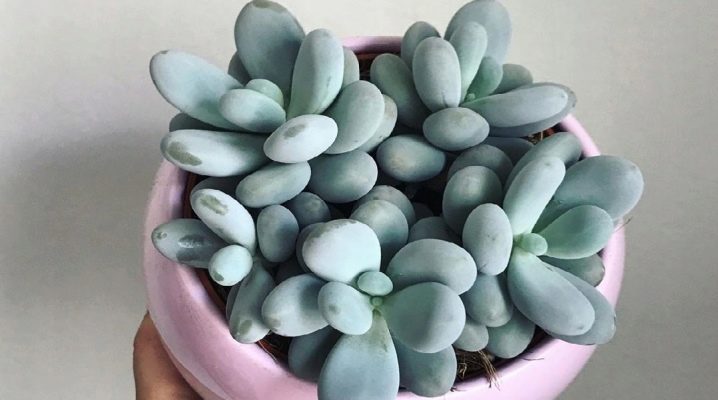
Pachyphytum is a small plant, unpretentious to care for. Grows well at home. With this succulent, it is convenient to create various compositions in the interior of the house and in the design of the site.
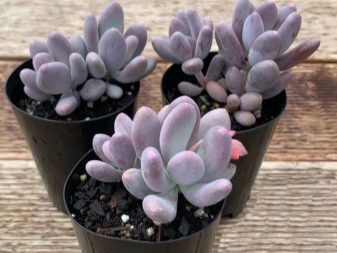
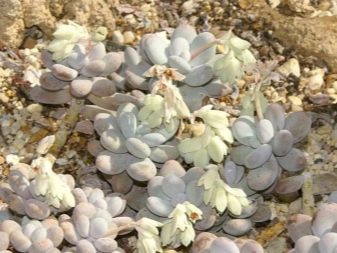
general description
The plant belongs to the Fat family... Succulent has leaves of various shapes: from ovoid to faceted. The leaf mass of the "moonstone" is juicy, voluminous, in color range from light gray to purple, covered with a waxy bloom from the outside. The size of the flower is always small: its height rarely reaches more than 30 centimeters. Leaf internodes of all varieties develop in a spiral manner, with the exception of long-leaved pachyphytum. Before flowering, the succulent produces long peduncles with small spike-shaped buds. The flower consists of five petals, similar to a bell.
The color range is from white to pink-red. In place of the fading inflorescence, pods are formed, in which the seeds ripen. Long bloom: from early July to mid-September. For the first time the plant was bred in the USA and Mexico, therefore the culture easily tolerates heat and drought.

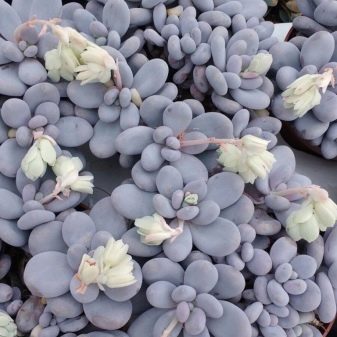
Before purchasing an exotic plant, you must read the following information:
- life cycle duration - 10 years;
- flowering - annual, once a year;
- when flowering, it emits a kind of sweetish aroma;
- the plant is not considered poisonous, but it is better not to taste it.
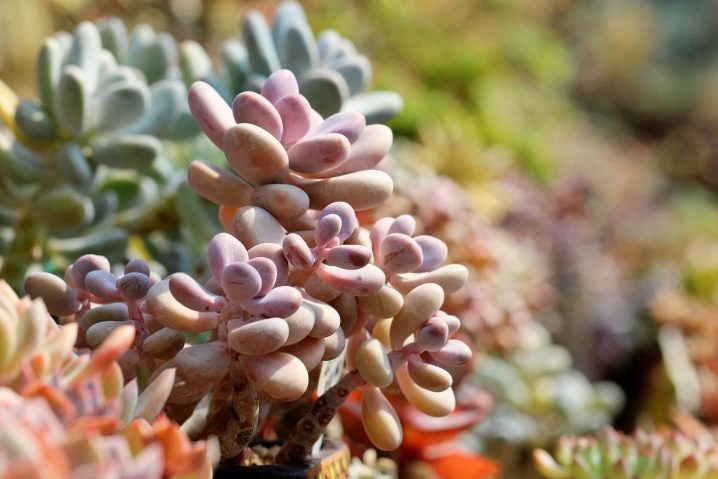
Popular types
In the natural environment, scientists have counted 10 varieties of this plant, but only a few species are cultivated at home.
- Oviferum egg-producing "Rubra" has creeping shoots up to 20 centimeters in length and up to one centimeter in diameter. At the base of the stem, branches grow without leaves, but with scars. The oval-shaped leaf mass is gray with a bloom. The length of each sheet is up to 5 centimeters. Flowering is white-pink inflorescences.

- Bracts "Bracteosum" has shoots 30 centimeters long. Leaves are dense, slightly elongated, up to 2 centimeters thick. Flowering is observed from August to November, the plant blooms with spike-shaped inflorescences with red petals. The length of the peduncles reaches 40 centimeters.

- "Compactum" has a miniature size. Stems 10 centimeters long are covered with a large amount of leaf mass. The leaves are cylindrical. It blooms from mid-April with red or orange bell-shaped flowers.

- Variety "Purple" has elongated foliage. Moreover, the length of each sheet plate reaches 7 centimeters. It blooms with dark pink flowers.
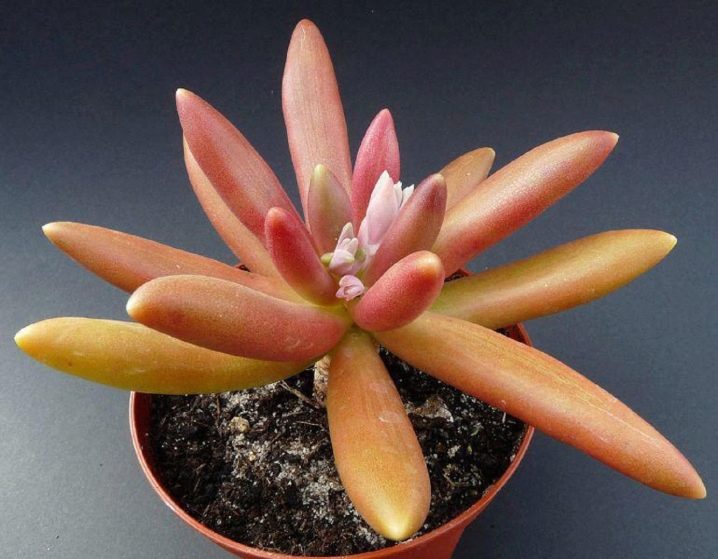
- Variety "Ganzhou" has a pink color of leaves, which are collected in an elegant rosette. When a large amount of sun hits the plants, the leaves change color to pink-purple. This variety is rarely cultivated at home.
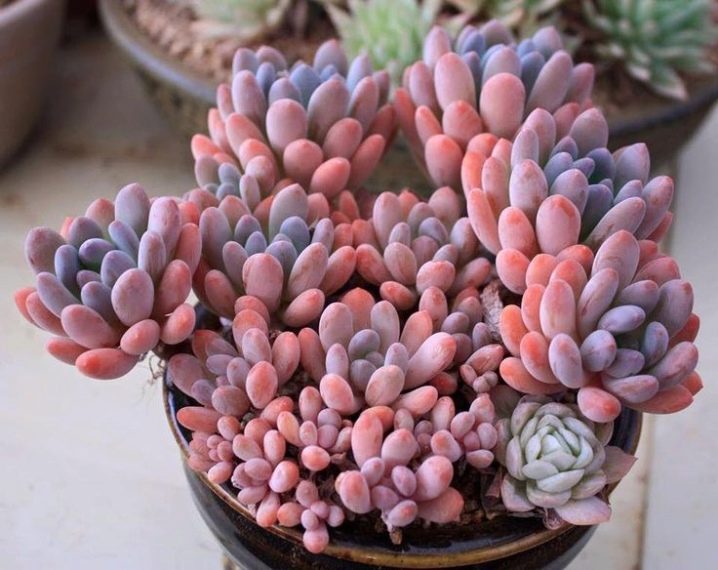
- "Glutinicaule" has oblong leaves with blunt tips. The entire surface of the leaf mass is covered with a bloom of a blue-gray hue, the culture blooms with pink flowers.

- A large variety is considered Fitkai Green. Finger-shaped foliage has a purple tint, changes color under intense light.

- Variety "Amethystium" is the rarest variety in our area. The leaves are small and have a pink tint.
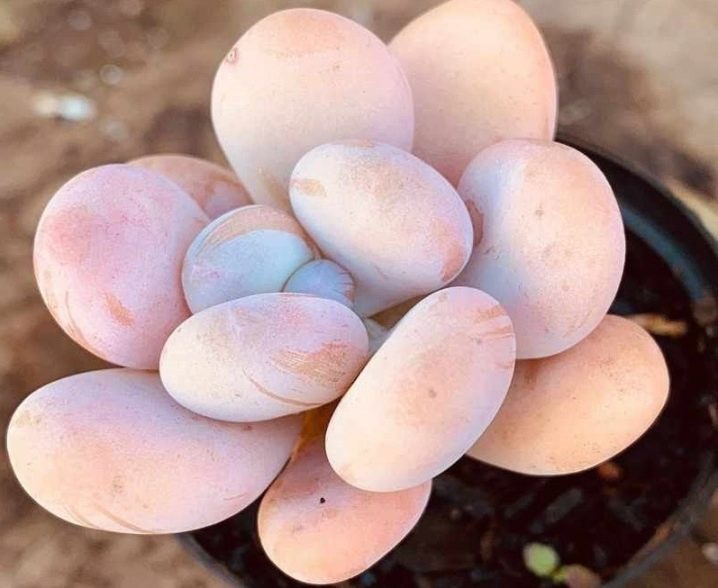
- Baby Finger - a compact plant with a lush gray-lilac leaf mass.Each leaf has a dark spot at the end. It grows in the mountainous part of Mexico.
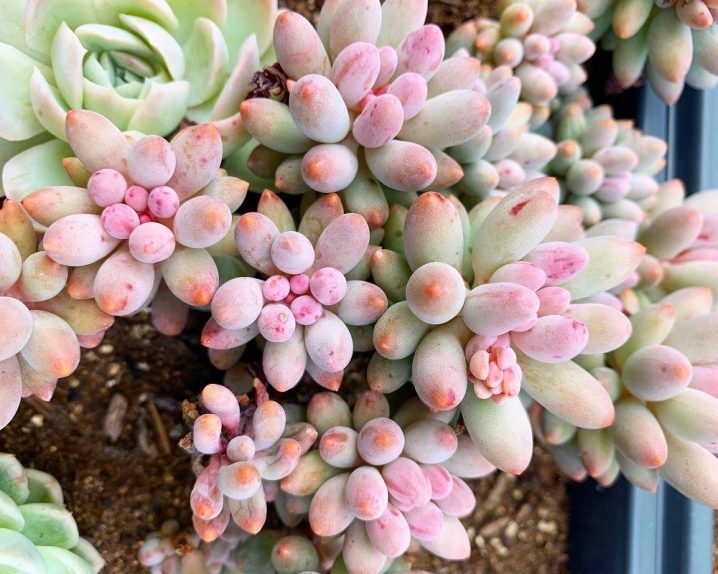
- Pachyphytum Verderman has dense green foliage. The leaf plates are juicy, short cylindrical in shape, up to 3 centimeters long.

- "Kimnachi" - This is a rather large plant that has sharp gray leaves. The plant has a peculiar plaque concentrated on the leaf plates, which is erased from a light touch. The variety is mainly propagated by cuttings.

Care
The flower culture does not require special conditions for itself. Therefore, both experienced florists and beginners can keep it.
Conditions
"Moonstone" loves bright lighting, but it must be slightly shaded from direct sunlight... The plant feels great on the east or west side. In the northern part of the house, it will also grow, but its color will change slightly. The plant will stop blooming. But in winter, pachyphytum will feel better on the south side.
In the warm season, for pachyphytum, it is necessary to create a temperature regime of 20-26 degrees. If the room becomes stuffy, and there is no air circulation, then the pot with the plant must be taken outside.
The culture loves frequent airing. Feels good in the summer on a balcony or terrace, but without contact with drafts and precipitation.
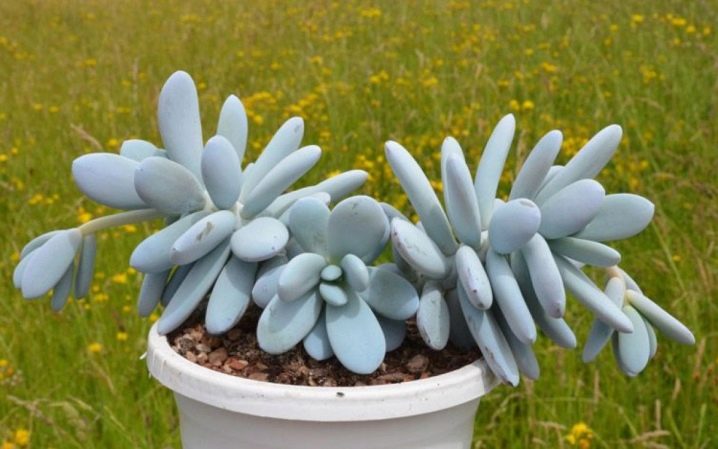
With the onset of autumn, the flower culture rests. Therefore, it can be placed in a place where the temperature does not rise above plus 16 degrees.
The average temperature graph looks like this:
- from mid-April to the end of summer - 20-26 degrees;
- the first two months of autumn - 18-20 degrees;
- from November to February - about 16 degrees, but not lower;
- March to mid-April - 18-20 degrees.
The plant does not need pruning and support. The tops are sometimes cut for the purpose of rejuvenation, and the cut parts are taken for rooting. Transplanting by the transshipment method is carried out no more often than once every two years. The container is always taken shallow, but one centimeter larger than the previous one, with excellent drainage. A newly purchased plant is kept in a container for a week, and then transplanted. As a rule, store soil is pure peat, but not for succulents. The plant will not develop in it, so it needs a transplant according to all the rules.

Watering
This is a drought-resistant plant, so frequent soil moisture is not required. If the soil in the pot is dry, then you need to think about watering. But you cannot pour water in large quantities, otherwise the root system will begin to rot. It is recommended to pour warm water from the edge of the pot. As a rule, in its natural environment, succulent grows in rather arid mountain areas, so at home you do not need to somehow moisten or spray it.
The correct watering schedule looks like this:
- from spring to late autumn - once a week;
- in hot summer - once every five days;
- in winter - no more than once a month.

Top dressing
With the onset of spring and until mid-autumn, it is necessary to fertilize the plant culture. It is necessary to use liquid fertilizers for succulents and apply them according to the instructions up to 4 times during the entire growing season. It is recommended to use formulations that are high in potassium but low in nitrogen.
It is better to use a dosage twice weaker than that indicated in the instructions for use.
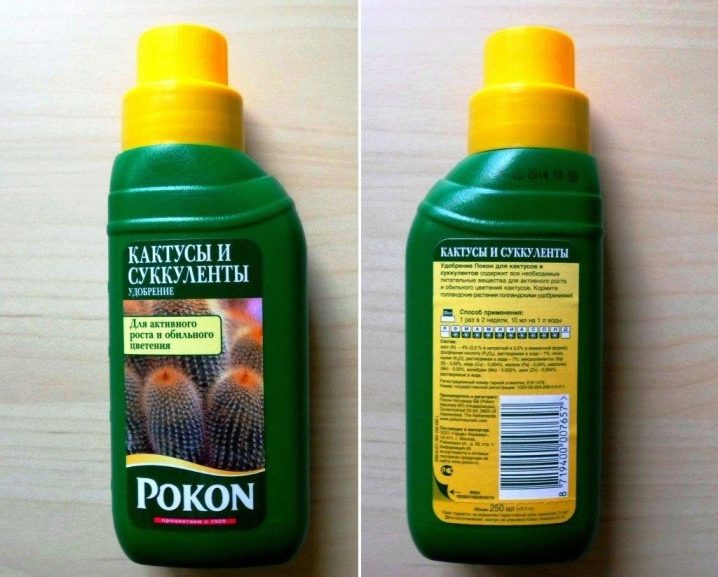
Reproduction
Pachyphytum can be propagated in three ways: by seeds, cuttings, and a leaf.
Seed propagation is used very rarely. This is because it is a difficult way. Seed material is very moody, quickly loses its germination due to the expired shelf life. Seeds are sown in loosened soil, consisting of sand and leafy soil. A wide flat box is recommended. The seeds are buried 0.5 centimeters into the pre-moistened soil. After that, cover with polyethylene or glass, send to a moderately lit place.It is necessary to ventilate the soil every day, and after the first shoots appear, it is necessary to completely remove the shelter. You should not dive the plant.
Cutting is the most acceptable way for all growers. To do this, choose lateral petioles up to 7 centimeters long. It is recommended to cut with a sharp blade so as not to injure the stem. The cut part is left to dry for several days. After the expiration date, the petiole can be buried in a mixture of sand and peat. It is best to water every day, but little by little, from the edge of the container. As soon as the exotic has new leaves, it means that it can be transplanted into a permanent container.
Leaf propagation is also practiced. For these purposes, in the central part of the outlet, it is necessary to carefully cut off the sheet. The sheet plate must be left to dry for a day. Next, the sheet should be sent to a moist soil. As soon as the new rosette takes root in the initial part of the leaf, it can be repotted.
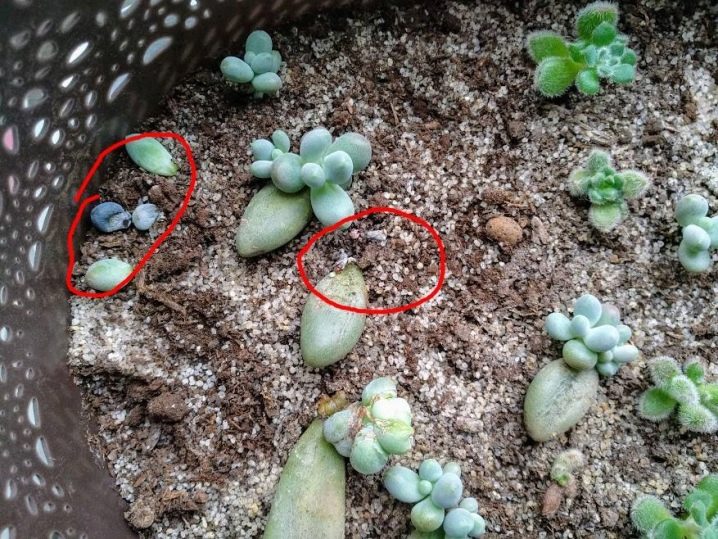
Important: during transplantation, you must not cover the sheet plate or stalk with polyethylene, glass. This can provoke the appearance of rot, which means that the future of culture will be in question.
For a plant, it is best to use ready-made soil for succulents or cacti. The soil should be neutral or slightly acidic. During planting, mix the prepared soil, fine gravel and sifted sand in a ratio of 3: 1: 1. You can combine the ready-made mixture with fine sand and vermiculite in the same proportions. Some also use shredded charcoal from birch firewood. This is done in order to saturate the plant with mineral fertilizers. If there is coal in the soil, then fertilizers are no longer needed.
It is better to use leafy ground rotted, in a crushed form. If sod soil is used, then it is better to take the one that grew in the meadow with an admixture of clay. The sand is taken from the river, sifted. Pebbles, broken brick or crushed stone are used in crushed form. Store-bought land needs fertilization.
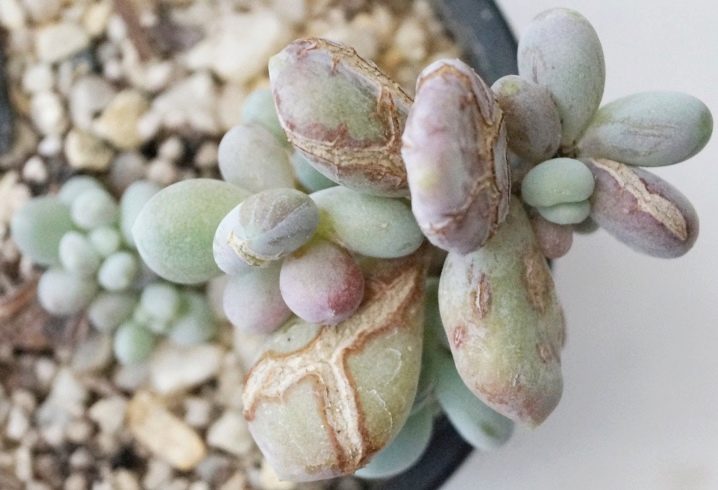
Diseases and pests
- The most common problem is considered to be a mealybug infestation. If suddenly during the active period there are problems with the growth and development of the succulent, then it must be removed from the container and carefully examined. The appearance of white bloom on the roots signals the effect of the pest. To bring the plant back to normal, it is recommended to shake the mixture from the roots and rinse them gently in warm water. With scissors, you need to cut off the rotted, dead and affected roots, let the pachyphytum dry and plant in a new mixture.
- One more problem - felter... A substance like cotton forms on the root system. If this happens, it is better to free the roots from the soil, rinse slightly and gently rinse with an alcohol solution. After drying, transplant the flower.
- If suddenly the leaves change color, the plant begins to fade, then it is overcome rot due to the large amount of moisture. To do this, it is recommended to change the soil and install rare watering.
- Shriveled leaves signal a lack of moisture in the soil. Watering needs to be adjusted.
- Brown blotches on leaf plates - decay of the root system due to waterlogging of the soil.
- The shoots are stretched - it means that the exotic does not have enough illumination... You need to change the location of the pot.
A succulent of southern origin, pachyphytum, has long been firmly established in the amateur circle of plants of domestic florists. Unpretentious care and decorativeness have made the "moonstone" a popular flower culture.

























































The comment was sent successfully.